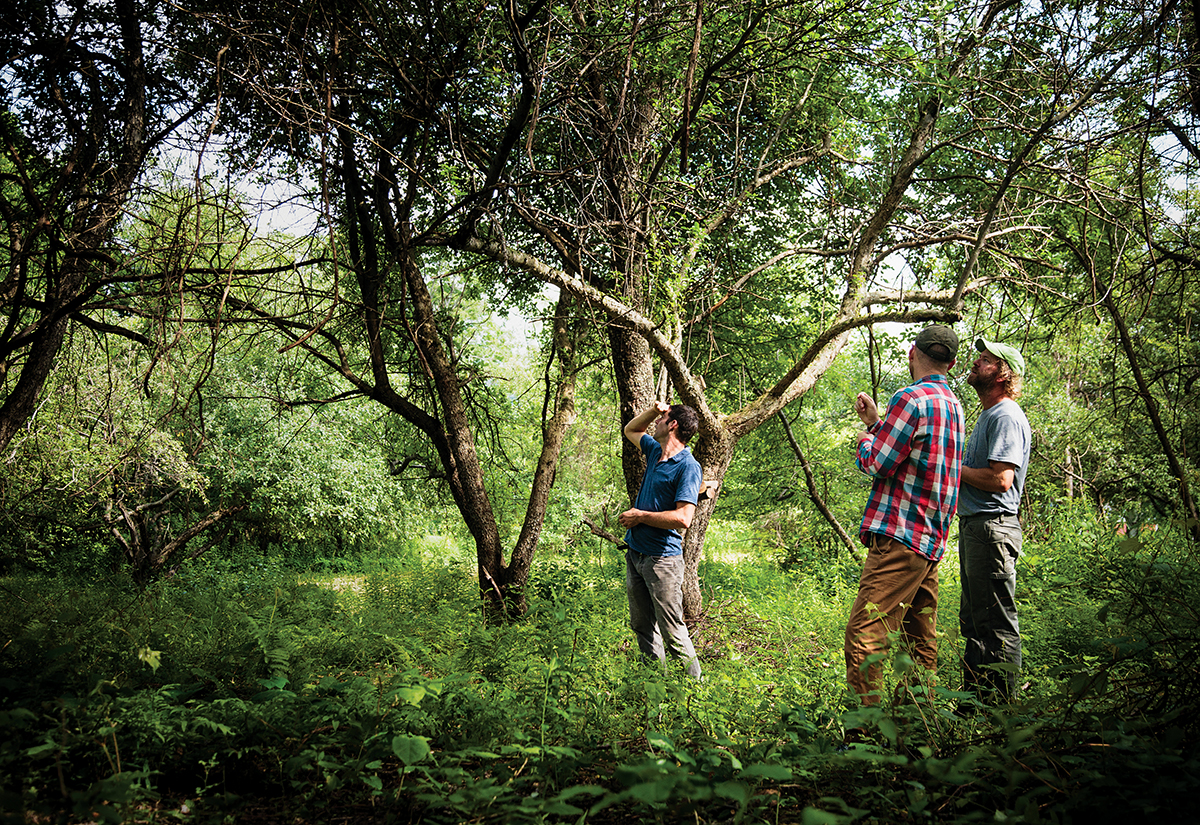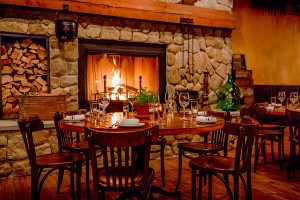The Hunt for the Tinmouth Apple

Apple hunters head into the wild unknown searching for the Holy Grail of cider apples. / Photograph by Pat Piasecki
The best apple you’ve never had is out there. Somewhere.
It’s not the tough and tangy Granny Smith, beloved by the Beatles and surrealist painter René Magritte. It’s not the Honeycrisp, the de rigueur dessert apple of the 21st century. And it’s definitely not that rubbery Red Delicious, loitering year round in your supermarket produce aisle.
Instead, this transcendent orb is unassuming, mottled, and misshapen, its flesh dense and mouth-puckering—what orchardists affectionately refer to as a “spitter.” But when pressed and fermented, it could blossom into liquid gold. With time and expertise, its nectar could become as layered and as nuanced as the great wines of France’s Loire Valley. Maybe even Champagne.
At least that’s what Shacksbury cofounder and cider maker Colin Davis is telling me as we careen around blind corners and gun down half-finished roads in Cornwall, Vermont, a rural hamlet 40 miles south of Burlington. Considering the steep inclines and rolling hills, not to mention Davis’s unflinching lead foot, I immediately start to question my guide’s choice in vehicles. His matchbox-size Honda Fit is woefully unsuited for the rugged terrain, each divot and deer track jolting our legs up through the floorboards. A plastic Kansas City Royals travel mug is doing pirouettes in the cup holder, its murky contents sloshing angrily, just waiting to extricate itself in a dramatic baptism of my face and lap.
For years, Davis has been consumed by the hunt for a possibly apocryphal apple known as the Tinmouth. In his 1905 book The Apples of New York—still considered the bible for self-proclaimed “apple geeks” like Davis—legendary horticulturist Spencer Ambrose Beach described the Tinmouth as “sprightly” and “peculiar” tasting. But today, that vague characterization is all that remains of the forgotten fruit; about a century ago it mysteriously vanished from New England, and therefore the world.
Finding the Tinmouth, and other lost species of cider apples, is a large part of Shacksbury’s business. As Davis steers us through fields of sugar maples and other deciduous trees, it’s hard to make out anything distinguishable in the gnarled overgrowth, let alone a grubby, golf-ball-size apple. But Davis keeps leaning across to point out promising wildlings, which, to my untrained eyes, look like everyday brush. We’ve been here once before: About a month ago, Davis brought me along with a small group of friends to a hidden, overgrown grove of wild apples—located deep in the woods on private land—that looked suspiciously like Tinmouths. In fact, Davis is quite certain of it. We have no idea if we’ll be able to find it again—but this time, Davis has brought reinforcements. So if we can find the old orchard, Davis is sure he’ll be able to definitively identify whether these are, indeed, the apples he’s been searching for.
On a typical apple-hunting adventure—one with less urgency than this—Davis will pull over, yank an apple from its knotty branches, and chomp down. Taste-testing the fruit is the best way to see if it’s of the bittersweet variety, which Davis says has an “extra dimension” not found in most commercial ciders. Hard cider is the fastest-growing category of alcoholic beverages in the United States; it’s projected to become a billion-dollar industry within the next several years. Until now, most of that growth has been driven by mass-appeal mega-brands such as Woodchuck and Boston Beer Company’s Angry Orchard, which tend to favor saccharine ciders made from common dessert apples like the McIntosh.
Despite the lure of easy profit, Davis and his business partner, David Dolginow, have never tried to capitalize on the lucrative sweet-cider trend. Instead, they’ve embarked on a far more ambitious—if not quixotic—quest for perfection. Their goal with Shacksbury, and in particular with the company’s offshoot, the Lost Apple Project, is essentially to bring America’s greatest apples back from the dead, scouring Vermont roadsides and pastures for forgotten strains that once lined the roads and property lines of Colonial New England.

Lee, Colin Davis, and Yoder navigate poisonous plants and thorny vines looking for the lost orchard. / Photograph by Pat Piasecki
Like sangiovese grapes in Tuscany, or pinot noir in Burgundy, apples such as the Tinmouth typically thrive in a single region. That’s why Dolginow sees New England—and its once-vaunted concentration of the world’s greatest apples—as, potentially, the cider-making equivalent of Napa Valley. By that analogy, Shacksbury is performing the same kind of pioneering work that was done by Joe Heitz, Robert Mondavi, and other post-Prohibition winemakers in northern California: resurrecting a hallowed region after a period of urbanization, reinvention, and neglect. If they’re right, they won’t just be players in the existing cider market—they’ll be creating an entirely new market from scratch.
While the Lost Apple Project has yet to turn a profit, it has become Davis and Dolginow’s obsession, and the heartbeat of the entire Shacksbury brand. “Down the road, when we have this bank of apples that no one else in the world has,” Davis says, “it’ll be a really valuable asset for us.” Which is why the pair has spent tens of thousands of dollars harvesting “lost” apples from feral fields and people’s backyards.
And it’s also why a caravan of cars, including Davis’s diminutive Honda Fit, is racing furiously toward the town of Tinmouth, Vermont, to see whether its eponymous fruit—perhaps the rarest cider apple of them all—is still out there.
It’s difficult to fathom how important the apple was to early America. Today, industrial-scale farming has squelched biodiversity, so that the broader market is dominated by just six varieties: Red Delicious, Golden Delicious, Gala, Fuji, Granny Smith, and McIntosh. But in the 18th and 19th centuries, American nurseries catalogued more than 16,000 different named apples, and as many as 7,500 American varieties. Apple trees were everywhere—particularly in New England, where they were used to mark property lines, like biological rock fences. Sugar was still a luxury good then, and apples sated the hungry colonists’ sweet tooths. But far more important, most apples were grown to make America’s national beverage: hard cider.
Up until Prohibition, Michael Pollan wrote in The Botany of Desire, “In rural areas cider took the place not only of wine and beer but of coffee and tea, juice, and even water.” It’s easy to see why: Until the 1900s, most water was contaminated with bacteria. Beyond issues of sanitation, cider was America’s homegrown answer to wine—our native grapes weren’t sweet enough to ferment. And just like European wines, American ciders could be incredibly complex, even nuanced—hence why Thomas Jefferson grew cider apples at Monticello, where Hewes Crabs are kept to this day.
Cider, not snacking, was the real reason John Chapman—better known as Johnny Appleseed—was flinging seeds and setting up nurseries through the Ohio Valley and the Midwest in the early 1800s. Growing apples is extremely easy, but cultivating a tree that bears palatable fruit is a rarity. Most of the chance seedlings that germinated in Chapman’s wake weren’t fit for his tin-pot hat—but they were plenty suited for a decent quaff, or even a nip of applejack. In fact, Chapman couldn’t possibly have known what he was growing. Apples are extremely heterozygous, meaning each seed contains the genetic makeup for a completely new and different type of apple tree. For instance, if you were to plant a seed from a McIntosh apple, the one thing you could be sure of is that the sapling it produced wouldn’t be a McIntosh tree. Instead—if you were lucky—you’d get something like the Macoun, a cross between a Mac and Jersey Black, which was developed in the New York State Agricultural Experiment Station, in Geneva, New York.

David Dolginow heads deeper into the forest. / Photograph by Pat Piasecki
That’s why apple farmers focus on the stem, not the seed. When Shacksbury finds a choice wildling—a wild apple tree, out in the brush—that they want to duplicate, they have to cut a scion—a branch with buds—and graft it onto the rootstock of an existing apple tree. This is, essentially, the art of cloning. The technique hasn’t changed significantly in hundreds of years, and it requires a skill that, even today, wows its practitioners. “Grafting, for me, despite having learned the science of it and done it many times, still has this mystical quality to it that feels similar to certain aspects of religion,” Dolginow says. “The fact that you can take one stick, wrap it in grafting putty to this other stick, and they grow together…it’s a tiny miracle.”
Early colonists had the foresight to bring over scions of their favorite European trees, but many of the grafts failed in the harsh New England climate. The millions of seeds they planted, on the other hand, flourished in their new home. Some 7,500 new varieties took root—several times what Europe had managed to produce in 3,000 years of cultivation. In the colonies, apple farmers identified the best of the new seedling trees, then grafted and propagated them in nurseries. The first of these distinguished new American cultivars, the Roxbury Russet, was discovered just outside of Boston in 1645.
Thanks to a perfect storm of seed and soil, the golden age of apples had arrived. By the mid-19th century, Americans were achieving fame and fortune just by finding the next Red Delicious or Grimes Golden. It was an era some called, appropriately enough, the Great Apple Rush. Unfortunately for the apple, the rush didn’t last. Soon, beer and wine surged in popularity, Prohibitionist Carrie Nation’s hatchet came calling, and grocery chains began demanding monocropped uniformity. By the time Prohibition ended in 1933, the apple had been reduced to a few baking varieties—the sweetest, shiniest, lipstick red among the thousands.
Elevated by industrial demand, these dessert apples choked out some of the most exquisite cider apples ever recorded. Unique specimens that could thrive only in New England were driven to the brink of extinction. In places like rural Vermont, a few hardy stragglers were swallowed up again by the forests, forgotten but for their names. Gone were the multitudinous arrays of what Ralph Waldo Emerson once called, with no small amount of pride, “the American fruit.”


